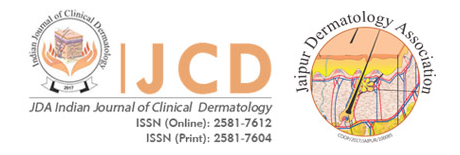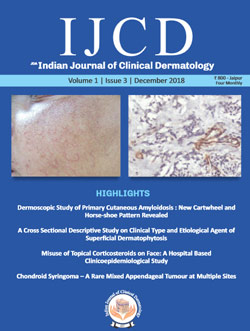LETTER TO EDITOR
Year: 2019 I Volume: 2 I Issue: 1 I Page: 14
Armoured Keloid
Dr. Jyoti Budhwar 1 , Dr. Chetna Singla1
1 Department of Dermatology, Sri Guru Ramdas Institute of Medical Sciences and Research, Vallah, Amritsar
Corresponding Author:
Dr. Jyoti Budhwar
MBBS, MD. Assistant Professor, Department of Dermatology, Venereology and Leprosy,
Sri Guru Ramdas Institute of Medical Sciences and Research, Vallah, Amritsar.
Email : drjyoti84@yahoo.in
How to cite this article:
Budhwar J, Singla C. Armoured Keloid. JDA Indian Journal of Clinical Dermatology 2019;2:
Sir,
Sir 1,2,3A56 years old female presented with hyperpigmented to skin coloured leathery plaque on the chest covering whole of her chest region just like a armour and left scapular area from the last ten years [fig-1, 2]. Similar hypertrophic lesion was present on left ear lobule almost obliterating it [fig-3]. Patient complained of severe itching and pain over the lesions. Clinical diagnosis of keloid was made and patient was advised biopsy, which she refused. Patient was given intralesional steroid injections on prominent borders twice and later on she was lost to follow-up.
 |
Figur 1: showing armoured keloid covering whole chest. |
 |
Figur 2: showing keloid on left scapular area |
 |
Figur 3: showing gaint keloid on left ear lobule almost obliterating it. |
Keloids are abnormal tissue response to cutaneous injury. They are benign fibro-collagenous growths that rise above the skin surface and extend beyond the borders of the original wound. They have a tendency to occur in areas of wound healing with increased tension such as chest, deltoid and back. They may also rarely regress spontaneously and show a high level of recurrence 1 after treatment and are known to be notorious for their poor response to treatment owing to complex and ill-deciphered pathophysiology. Recent studies indicate that transforming growth factor beta and platelet-derived growth factor play an integral role in the formation of keloids. Diagnosis is based on history and clinical examination and is confirmed by histopathology. Treatment modalities include but are not limited to simple excision, intralesional excision, local irradiation, steroid therapy, pressure therapy, cryotherapy, silicone gel application and enzyme therapy, alone or in combination. No single modality is 100% effective and recurrence rates range from 50% to 100%.3
References:
1. Ranjan SK, Ahmed A, Harsh V, Jha NK. Giant bilateral keloids of the ear lobule: Case report and brief review of literature. J Family Med Prim Care. 2017;6(3):677–679. doi:10.4103/2249-4863.222053
2. Berman B, Perez OA. Keloid and hypertrophic scar. Available at: http://www.emedicine.com/ derm/topic205.htm.
3. Joseph JS, Susan CT, Fran CB. Keloidal scars: a review with a critical look at therapeutic options. J Am Acad Dermatol. 2002;46:s63-77.

